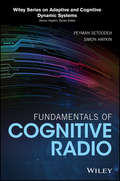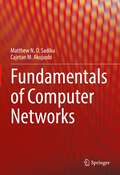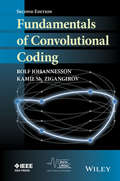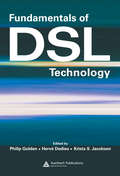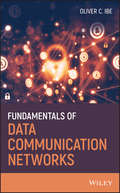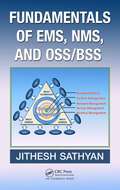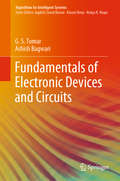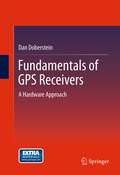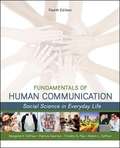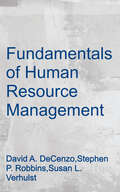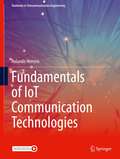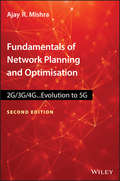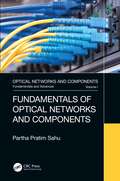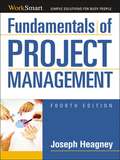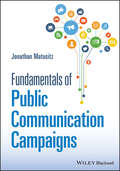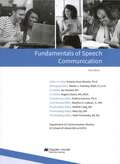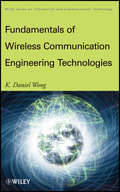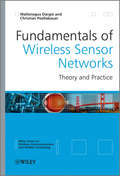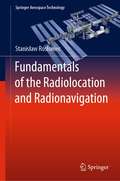- Table View
- List View
Fundamentals of Cognitive Radio
by Simon Haykin Peyman SetoodehA comprehensive treatment of cognitive radio networks and the specialized techniques used to improve wireless communications The human brain, as exemplified by cognitive radar, cognitive radio, and cognitive computing, inspires the field of Cognitive Dynamic Systems. In particular, cognitive radio is growing at an exponential rate. Fundamentals of Cognitive Radio details different aspects of the human brain and provides examples of how it can be mimicked by cognitive dynamic systems. The text offers a communication-theoretic background, including information on resource allocation in wireless networks and the concept of robustness. The authors provide a thorough mathematical background with data on game theory, variational inequalities, and projected dynamic systems. They then delve more deeply into resource allocation in cognitive radio networks. The text investigates the dynamics of cognitive radio networks from the perspectives of information theory, optimization, and control theory. It also provides a vision for the new world of wireless communications by integration of cellular and cognitive radio networks. This groundbreaking book: Shows how wireless communication systems increasingly use cognition to enhance their networks Explores how cognitive radio networks can be viewed as spectrum supply chain networks Derives analytic models for two complementary regimes for spectrum sharing (open-access and market-driven) to study both equilibrium and disequilibrium behaviors of networks Studies cognitive heterogeneous networks with emphasis on economic provisioning for resource sharing Introduces a framework that addresses the issue of spectrum sharing across licensed and unlicensed bands aimed for Pareto optimality Written for students of cognition, communication engineers, telecommunications professionals, and others, Fundamentals of Cognitive Radio offers a new generation of ideas and provides a fresh way of thinking about cognitive techniques in order to improve radio networks.
Fundamentals of Computer Networks
by Cajetan M. Akujuobi Matthew N. SadikuThis textbook presents computer networks to electrical and computer engineering students in a manner that is clearer, more interesting, and easier to understand than other texts. All principles are presented in a lucid, logical, step-by-step manner. As much as possible, the authors avoid wordiness and giving too much detail that could hide concepts and impede overall understanding of the material. Ten review questions in the form of multiple-choice objective items are provided at the end of each chapter with answers. The review questions are intended to cover the little “tricks” which the examples and end-of-chapter problems may not cover. They serve as a self-test device and help students determine how well they have mastered the chapter.
Fundamentals of Convolutional Coding
by Rolf Johannesson Kamil Sh. ZigangirovFundamentals of Convolutional Coding, Second Edition, regarded as a bible of convolutional coding brings you a clear and comprehensive discussion of the basic principles of this field Two new chapters on low-density parity-check (LDPC) convolutional codes and iterative coding Viterbi, BCJR, BEAST, list, and sequential decoding of convolutional codes Distance properties of convolutional codes Includes a downloadable solutions manual
Fundamentals of DSL Technology
by Hervé Dedieu Philip Golden Krista JacobsenThe DSL arena is expanding rapidly, making it highly unlikely that any single author can adequately address the breadth and depth of the subject. Responding to the demand of designers worldwide, Fundamentals of DSL Technology combines the strengths of the field's most renowned DSL experts, providing a foundation of all aspects of DSL system design.
Fundamentals of Data Communication Networks
by Oliver C. IbeWhat every electrical engineering student and technical professional needs to know about data exchange across networks While most electrical engineering students learn how the individual components that make up data communication technologies work, they rarely learn how the parts work together in complete data communication networks. In part, this is due to the fact that until now there have been no texts on data communication networking written for undergraduate electrical engineering students. Based on the author’s years of classroom experience, Fundamentals of Data Communication Networks fills that gap in the pedagogical literature, providing readers with a much-needed overview of all relevant aspects of data communication networking, addressed from the perspective of the various technologies involved. The demand for information exchange in networks continues to grow at a staggering rate, and that demand will continue to mount exponentially as the number of interconnected IoT-enabled devices grows to an expected twenty-six billion by the year 2020. Never has it been more urgent for engineering students to understand the fundamental science and technology behind data communication, and this book, the first of its kind, gives them that understanding. To achieve this goal, the book: Combines signal theory, data protocols, and wireless networking concepts into one text Explores the full range of issues that affect common processes such as media downloads and online games Addresses services for the network layer, the transport layer, and the application layer Investigates multiple access schemes and local area networks with coverage of services for the physical layer and the data link layer Describes mobile communication networks and critical issues in network security Includes problem sets in each chapter to test and fine-tune readers’ understanding Fundamentals of Data Communication Networks is a must-read for advanced undergraduates and graduate students in electrical and computer engineering. It is also a valuable working resource for researchers, electrical engineers, and technical professionals.
Fundamentals of Digital Communication
by Upamanyu MadhowThis is a concise presentation of the concepts underlying the design of digital communication systems, without the detail that can overwhelm students. Many examples, from the basic to the cutting-edge, show how the theory is used in the design of modern systems and the relevance of this theory will motivate students. The theory is supported by practical algorithms so that the student can perform computations and simulations. Leading edge topics in coding and wireless communication make this an ideal text for students taking just one course on the subject. Fundamentals of Digital Communications has coverage of turbo and LDPC codes in sufficient detail and clarity to enable hands-on implementation and performance evaluation, as well as 'just enough' information theory to enable computation of performance benchmarks to compare them against. Other unique features include space-time communication and geometric insights into noncoherent communication and equalization.
Fundamentals of EMS, NMS and OSS/BSS
by Jithesh SathyanIn this era where data and voice services are available at a push of a button, service providers have virtually limitless options for reaching their customers with value-added services. The changes in services and underlying networks that this always-on culture creates make it essential for service providers to understand the evolving business logi
Fundamentals of Electro-Optic Systems Design
by Sherman Karp Larry B. StottsUsing fundamentals of communication theory, thermodynamics, information theory and propagation theory, this book explains the universal principles underlying a diverse range of electro-optical systems. From fiber optics and infra-red imaging to free space communications and laser remote sensing, the authors relate key concepts in science and device engineering to practical systems issues. A broad spectrum of coherent and incoherent imaging and communications systems is considered, accompanied by many real-world examples. The authors also present new insights into LIDAR and free space communications and imaging, providing practical guidance on identifying the fundamental limitations of transmission and imaging through deleterious channels. Accompanied by online examples of processed images and videos, this uniquely tailored guide to the fundamental principles underlying modern electro-optical systems is an essential reference for all practising engineers and academic researchers in optical engineering.
Fundamentals of Electronic Devices and Circuits (Algorithms for Intelligent Systems)
by G.S. Tomar Ashish BagwariThis book focuses on conceptual frameworks that are helpful in understanding the basics of electronics – what the feedback system is, the principle of an oscillator, the operational working of an amplifier, and other relevant topics. It also provides an overview of the technologies supporting electronic systems, like OP-AMP, transistor, filter, ICs, and diodes. It consists of seven chapters, written in an easy and understandable language, and featuring relevant block diagrams, circuit diagrams, valuable and interesting solved examples, and important test questions. Further, the book includes up-to-date illustrations, exercises, and numerous worked examples to illustrate the theory and to demonstrate their use in practical designs.
Fundamentals of GPS Receivers
by Dan DobersteinFundamentals of GPS receivers covers GPS receivers' theory and practice. The book begins with the basics of GPS receivers and moves onward to more advanced material. The book examines three types of GPS receiver implementations: first is the custom design by the author; second is an industry standard design, now part of the open source network; the third relates to the receiver designed by JPL /NASA. Each receiver is unique allowing the reader to see how each design solves the same problems. Chapters discuss carrier phase measurements and GPS time and frequency measurements. The overall text is measurement oriented as opposed to processing the measurements. With a focus on the fundamentals of measurements the reader will be building their intuition for the physical phenomenon at work.
Fundamentals of Human Communication: Social Science in Everyday Life, Fourth Edition
by Melvin L. Defleur Patricia Kearney Margaret H. Defleur Timothy G. PlaxThis book presents the basic theoretical and practical concepts of the human communication process. DeFleur uses a multidisciplinary approach, with a balance of innovative and traditional perspectives to give students the tools to communicate effectively in the workplace and in everyday situations.
Fundamentals of Human Resource Management
by Stephen P. Robbins David A. DeCenzo Susan L. VerhulstThe 12th Edition of Fundamentals of Human Resource Management, Binder Ready Version, 12th Edition helps students understand and remember concepts through a straightforward and conversational writing style and a wealth of examples to clarify ideas and build interest. The authors provide a strong foundation of essential elements of Human Resource Management as well as a clear understanding of how Human Resource Management links with business strategy. Through practical applications, the authors illustrate the importance of employees on every level of the organization, helping students understand HRM elements such as recruitment, training, motivation, retention, safety, the legal environment, and how they support successful business strategies.
Fundamentals of IoT Communication Technologies (Textbooks In Telecommunication Engineering Ser.)
by Rolando HerreroThis textbook explores all of the protocols and technologies essential to IoT communication mechanisms. Geared towards an upper-undergraduate or graduate level class, the book is presented from a perspective of the standard layered architecture with special focus on protocol interaction and functionality. The IoT protocols are presented and classified based on physical, link, network, transport and session/application layer functionality. The author also lets readers understand the impact of the IoT mechanisms on network and device performance with special emphasis on power consumption and computational complexity. Use cases – provided throughout – provide examples of IoT protocol stacks in action. The book is based on the author’s popular class “Fundamentals of IoT” at Northeastern University. The book includes examples throughout and slides for classroom use. Also included is a 'hands-on’ section where the topics discussed as theoretical content are built as stacks in the context of an IoT network emulator so readers can experiment.
Fundamentals of Network Planning and Optimisation 2G/3G/4G: Evolution to 5G
by Ajay R. MishraUpdated new edition covering all aspects of network planning and optimization This welcome new edition provides comprehensive coverage of all aspects of network planning in all the technologies, from 2G to 5G, in radio, transmission and core aspects. Written by leading experts in the field, it serves as a handbook for anyone engaged in the study, design, deployment and business of cellular networks. It increases basic understanding of the currently deployed, and emerging, technologies, and helps to make evolution plans for future networks. The book also provides an overview of the forthcoming technologies that are expected to make an impact in the future, such as 5G. Fundamentals of Cellular Network Planning and Optimization, Second Edition encompasses all the technologies as well as the planning and implementation details that go with them. It covers 2G (GSM, EGPRS), 3G (WCDMA) and 4G (LTE) networks and introduces 5G. The book also looks at all the sub-systems of the network, focusing on both the practical and theoretical issues. Provides comprehensive coverage of the planning aspects of the full range of today's mobile network systems, covering radio access network, circuit and packet switching, signaling, control, and backhaul/Core transmission networks New elements in book include HSPA, Ethernet, 4G/LTE and 5G Covers areas such as Virtualization, IoT, Artificial Intelligence, Spectrum Management and Cloud By bringing all these concepts under one cover, Fundamentals of Cellular Network Planning and Optimization becomes essential reading for network design engineers working with cellular service vendors or operators, experts/scientists working on end-to-end issues, and undergraduate/post-graduate students.
Fundamentals of Optical Networks and Components
by Partha Pratim SahuThis book is intended as an undergraduate/postgraduate level textbook for courses on high-speed optical networks as well as computer networks. Nine chapters cover the basic principles of the technology and different devices for optical networks, as well as processing of integrated waveguide devices of optical networks using different technologies. It provides students, researchers and practicing engineers with an expert guide to the fundamental concepts, issues and state-of-the-art developments in optical networks. It includes examples throughout all the chapters of the book to aid understanding of basic problems and solutions. Presents basics of the optical network devices and discusses latest developments Includes examples and exercises throughout all the chapters of the book to aid understanding of basic problems and solutions for undergraduate and postgraduate students Discusses different optical network node architectures and their components Includes basic theories and latest developments of hardware devices with their fabrication technologies (such as optical switch, wavelength router, wavelength division multiplexer/demultiplexer and add/drop multiplexer), helpful for researchers to initiate research on this field and to develop research problem-solving capability Reviews fiber-optic networks without WDM and single-hop and multi-hop WDM optical networks P. P. Sahu received his M.Tech. degree from the Indian Institute of Technology Delhi and his Ph.D. degree in engineering from Jadavpur University, India. In 1991, he joined Haryana State Electronics Development Corporation Limited, where he has been engaged in R&D works related to optical fiber components and telecommunication instruments. In 1996, he joined Northeastern Regional Institute of Science and Technology as a faculty member. At present, he is working as a professor in the Department of Electronics and Communication Engineering, Tezpur Central University, India. His field of interest is integrated optic and electronic circuits, wireless and optical communication, clinical instrumentation, green energy, etc. He has received an INSA teacher award (instituted by the highest academic body Indian National Science Academy) for high level of teaching and research. He has published more than 90 papers in peer-reviewed international journals, 60 papers in international conference, and has written five books published by Springer Nature, McGraw-Hill. Dr Sahu is a Fellow of the Optical Society of India, Life Member of Indian Society for Technical Education and Senior Member of the IEEE.
Fundamentals of Organizational Communication: Knowledge, Sensitivity, Skills, Values
by Pamela S. Shockley-ZalabakThis book helps readers experience twenty-first-century organizational challenges within the context of learning about communication and organizations. The eighth edition of this book presents the concepts of organizational communication within a unique competency-based approach that incorporates personal knowledge, interpersonal sensitivity, communication skills, and ethical values. It blends theory, practice, and analysis with an emphasis on knowledge, sensitivity, skills, and values.
Fundamentals of Project Management (Worksmart Ser.)
by Joseph HeagneyWith sales of more than 160,000 copies, Fundamentals of Project Management has helped generations of project managers navigate the ins and outs of every aspect of this complex discipline. Using a simple step-by-step approach, the book is the perfect introduction to project management tools, techniques, and concepts. Readers will learn how to: • Develop a mission statement, vision, goals, and objectives • Plan the project • Create the work breakdown structure • Produce a workable schedule • Understand earned value analysis • Manage a project team • Control and evaluate progress at every stage. Fully updated based on the latest version of the Project Management Body of Knowledge (PMBOK®), the fourth edition contains new information and expanded coverage on the project risk plan; the change control process; the concept of the project manager as leader; and more. This up-to-the-minute guide is filled with tips and techniques for planning and executing projects on time, on budget, and with maximum efficiency.
Fundamentals of Public Communication Campaigns
by Jonathan MatusitzThe most comprehensive and up-to-date textbook on public communication campaigns currently available Fundamentals of Public Communication Campaigns provides students and practitioners with the theoretical and practical knowledge needed to create and implement effective messaging campaigns for an array of real-world scenarios. Assuming no prior expertise in the subject, this easily accessible textbook clearly describes more than 700 essential concepts of public communication campaigns. Numerous case studies illustrate real-world media campaigns, such as those promoting COVID–19 vaccinations and social distancing, campaigns raising awareness of LGBTQ+ issues, entertainment and Hollywood celebrity campaigns, and social activist initiatives including the #MeToo movement and Black Lives Matter (BLM). Opening with a thorough introduction to the fundamentals of public communication campaigns, the text examines a wide array of different health communication campaigns, social justice and social change campaigns, and counter-radicalization campaigns. Readers learn about the theoretical foundations of public communication campaigns, the roles of persuasion and provocation, how people&’s attitudes can be changed through fear appeals, the use of ethnographic research in designing campaigns, the ethical principles of public communication campaigns, the potential negative effects of public messaging, and much more. Describes each of the 10 steps of public communication campaigns, from defining the topic and setting objectives to developing optimal message content and updating the campaign with timely and relevant information Covers public communication campaigns from the United States as well as 25 other countries, including Australia, Brazil, Canada, China, Egypt, India, Israel, Singapore, South Korea, and the United Kingdom Offers a template for creating or adapting messages for advertising, public relations, health, safety, entertainment, social justice, animal rights, and many other scenarios Incorporates key theories such as the Diffusion of Innovations (DoI) theory, social judgment theory (SJT), the Health Belief Model (HBM), social cognitive theory (SCT), and self–determination theory (SDT) Includes in-depth case studies of communication campaigns of Islamophobia, antisemitism, white supremacism, and violent extremism.Fundamentals of Public Communication Campaigns is the perfect textbook for undergraduate students across the social sciences and the humanities, and a valuable resource for general readers with interest in the subject.
Fundamentals of Speech Communication (Custom)
by Indiana UniversityFundamentals of Speech Communication (Custom) - 3rd edition
Fundamentals of Translation
by Sonia ColinaClear and concise, this textbook provides a non-technical introduction to the basic and central concepts of translation theory and practice, including translation briefs, parallel texts and textual functions, cohesion and coherence, and old and new information. Colina focuses on the key concepts that beginning students of translation, practising translators, language students and language professionals need to understand. Numerous exercises (discussion, group and individual) at the end of each chapter and 'Practice' activities throughout each chapter allow students to self-assess their practical understanding of chapter topics. In addition, examples, figures and text extracts from a wide variety of world languages contextualise chapter material and produce a lively and accessible narrative. Suitable for non-specialists with no prior experience of translation, it will also be of interest to practising translators, language students and language industry professionals who wish to gain a wider and up-to-date understanding of translation.
Fundamentals of Wireless Communication Engineering Technologies
by K. Daniel WongA broad introduction to the fundamentals of wireless communication engineering technologies Covering both theory and practical topics, Fundamentals of Wireless Communication Engineering Technologies offers a sound survey of the major industry-relevant aspects of wireless communication engineering technologies. Divided into four main sections, the book examines RF, antennas, and propagation; wireless access technologies; network and service architectures; and other topics, such as network management and security, policies and regulations, and facilities infrastructure. Helpful cross-references are placed throughout the text, offering additional information where needed. The book provides: Coverage that is closely aligned to the IEEE's Wireless Communication Engineering Technologies (WCET) certification program syllabus, reflecting the author's direct involvement in the development of the program A special emphasis on wireless cellular and wireless LAN systems An excellent foundation for expanding existing knowledge in the wireless field by covering industry-relevant aspects of wireless communication Information on how common theories are applied in real-world wireless systems With a holistic and well-organized overview of wireless communications, Fundamentals of Wireless Communication Engineering Technologies is an invaluable resource for anyone interested in taking the WCET exam, as well as practicing engineers, professors, and students seeking to increase their knowledge of wireless communication engineering technologies.
Fundamentals of Wireless Sensor Networks
by Waltenegus Dargie Christian PoellabauerIn this book, the authors describe the fundamental concepts and practical aspects of wireless sensor networks. The book provides a comprehensive view to this rapidly evolving field, including its many novel applications, ranging from protecting civil infrastructure to pervasive health monitoring. Using detailed examples and illustrations, this book provides an inside track on the current state of the technology. The book is divided into three parts. In Part I, several node architectures, applications and operating systems are discussed. In Part II, the basic architectural frameworks, including the key building blocks required for constructing large-scale, energy-efficient sensor networks are presented. In Part III, the challenges and approaches pertaining to local and global management strategies are presented - this includes topics on power management, sensor node localization, time synchronization, and security. At the end of each chapter, the authors provide practical exercises to help students strengthen their grip on the subject. There are more than 200 exercises altogether.Key Features:Offers a comprehensive introduction to the theoretical and practical concepts pertaining to wireless sensor networks Explains the constraints and challenges of wireless sensor network design; and discusses the most promising solutions Provides an in-depth treatment of the most critical technologies for sensor network communications, power management, security, and programming Reviews the latest research results in sensor network design, and demonstrates how the individual components fit together to build complex sensing systems for a variety of application scenarios Includes an accompanying website containing solutions to exercises (http://www.wiley.com/go/dargie_fundamentals) This book serves as an introductory text to the field of wireless sensor networks at both graduate and advanced undergraduate level, but it will also appeal to researchers and practitioners wishing to learn about sensor network technologies and their application areas, including environmental monitoring, protection of civil infrastructure, health care, precision agriculture, traffic control, and homeland security.
Fundamentals of the Radiolocation and Radionavigation (Springer Aerospace Technology)
by Stanisław RosłoniecThe book presents principles of operation of radar and radionavigation systems. The group of radar systems includes: primary and secondary radiolocations, bistatic and multistatic systems. They are illustrated with relevant examples of calculation and applications. The issues of increasing the range of the radar systems are presented together with the matched filtering of the used signals. Other discussed issues are methods for eliminating interfering signals and researching methods of 3D space. Various methods of the monopulse radiolocation are presented in Chapter 12. In Chapters 13–18 terrestrial and satellite radionavigation systems are under discussion. The terrestrial systems are: Loran C, Decca Navigator and Omega. The TRANSIT is an example of a hyperbolic satellite system. The stadiometric systems GPS, GLONASS, GALILEO, BeiDou, IRNSS and QZSS are discussed together with differential systems augmentating of them. The ILS, MLS and TLS supporting the landing of aircrafts are discussed in Chapter 17. The prospects for replacing of them with satellite systems augmentated by appropriate reference ground-based stations (GBAS) are also analyzed. Various beacons and ranging devices used in aviation are described in the Chapter 18. This book is intended primarily for students and engineers interested in radar, radionavigation and aerospace engineering.
Funded: The Entrepreneur's Guide to Raising Your First Round
by Katherine HagueThe venture capital world is often intimidating and hard to navigate, even for the most seasoned entrepreneurs. But it doesn’t have to be. Entrepreneurs who run effective fundraising processes don’t do it by accident. With this book, you’ll learn what it takes to successfully raise a round of funding for your company.Author Katherine Hague explains how the venture capital industry works, and walks you through each step necessary to plan, execute, and optimize your own fundraising round. Packed full of exercises, checklists, and templates, this book guides you through the process from start to finish. It’s ideal for entrepreneurs raising later rounds of capital, as well as those just starting out.Gain an understanding of core venture capital concepts and standardsLearn how to develop and hone an investor pitchCome away with a plan to hit the fundraising trail for your companyDevelop the confidence you need to negotiate key terms in a funding dealUnderstand best practices in fundraising, and learn how to avoid the top 10 fundraising mistakes
Funny Because It's True: How The Onion Created Modern American News Satire
by Christine WencDiscover the real truth behind the original fake news with this in-depth history of beloved humor publication, The Onion. In 1988, a band of University of Wisconsin–Madison undergrads and dropouts began publishing a free weekly newspaper with no editorial stance other than &“You Are Dumb.&” Just wanting to make a few bucks, they wound up becoming the bedrock of modern satire over the course of twenty years, changing the way we consume both our comedy and our news. The Onion served as a hilarious and brutally perceptive satire of the absurdity and horrors of late twentieth-century American life and grew into a global phenomenon. Now, for the first time, the full history of the publication is told by one of its original staffers, author and historian Christine Wenc. Through dozens of interviews, Wenc charts The Onion&’s rise, its position as one of the first online humor sites, and the way it influenced television programs like The Daily Show and The Colbert Report. Funny Because It&’s True peels back the layers to reveal how a group of young misfits from flyover country unintentionally created a cultural phenomenon.
